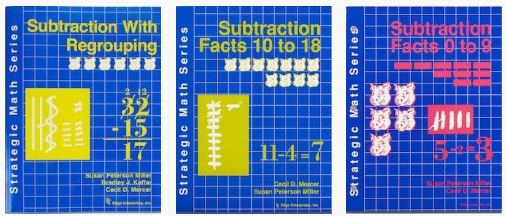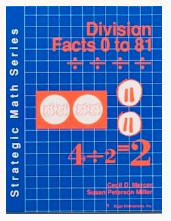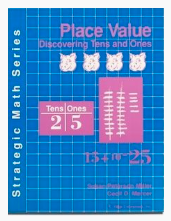
SIM Math Strategies
The SIM Math Strategies provide teachers with instructional supports and procedures, covering everything from addition to division.
SIM Math Strategies BrochureThe SIM Math Strategies use a concrete-representational-abstract (CRA) method of instruction to help students master math. The SIM Math Strategies are:
- Addition Facts 0 to 9
- Addition Facts 10 to 18
- Addition with Regrouping
- Addition within 20
- Division Facts 0 to 81
- Multiplication Facts 0 to 81
- Multiplication with Regrouping: Partial Products
- Multiplication with Regrouping: Standard Algorithm
- Place Value: Discovering Tens and Ones
- Subtraction Facts 0 to 9
- Subtraction Facts 10 to 18
- Subtraction with Regrouping

ADDITION
Addition Facts 0 to 9 provides a systematic means for teaching addition problems that involve only the numerals 0 through 9 and that contain no sum greater than 9.
Addition Facts 10 to 18 provides the materials you need to teach addition facts using the CRA method of instruction, including specific teaching procedures and student materials for each lesson.
The specialized instruction in the Addition with Regrouping program includes concrete and representational lessons that involve the use of base-ten blocks and drawings to represent the regrouping process. These three- and two-dimensional models ensure that students conceptually understand WHY regrouping is needed. This understanding enables students to determine when regrouping is needed, remember the process involved in regrouping 10 ones into a ten or 10 tens into a hundred, and retain this important information over time.
Addition within 20 is for students who may have memorized some addition facts, but are not fluent in addition facts with sums between 10 and 20, do not show an understanding of addition and its relation to subtraction, or have enough number knowledge or flexibility to solve unknown addition problems.

SUBTRACTION
Subtraction Facts 0 to 9 provides all the materials you need to teach subtraction facts using the CRA method of instruction. The manual outlines specific teaching procedures for each lesson and includes student tests, progress charts, learning sheets, and more.
Subtraction Facts 10 to 18 provides all of the materials you need to teach subtraction with two digits using the CRA method of instruction, including student materials and specific teaching procedures for each lesson.
The approach in the Subtraction with Regrouping program emphasizes a gradual progression through concrete, representational, and abstract lessons and promotes a deep level of understanding related to the regrouping process. Base-ten blocks and drawings are used to provide models that ensure student understanding. Clever strategies are used to facilitate memory of important steps to follow when solving these challenging problems. Emphasis is placed on helping students determine whether or not regrouping is required.

MULTIPLICATION
Multiplication Facts 0 to 81 provides all of the materials you need to teach multiplication facts using the CRA method of instruction. The manual outlines specific teaching procedures for each lesson and includes student tests, progress charts, practice sheets, and more.
Multiplication with Regrouping: Partial Products applies the CRA teaching sequence from the Strategic Math Series to multiplication with regrouping. The Partial Products book shows students how to break numbers into parts, multiply those parts, and then add the partial products to find the final product. Students not only master multiplication, but come to understand exactly what they are doing and why.
Multiplication with Regrouping: Standard Algorithm applies the CRA teaching sequence from the Strategic Math Series to multiplication with regrouping. The Standard Algorithm book shows students the shortened way to multiply and regroup. Students not only master multiplication, but come to understand exactly what they are doing and why.

DIVISION
Division Facts 0 to 81 provides all of the materials you need to teach division facts using the concrete-representational-abstract method of instruction. The manual outlines specific teaching procedures for each lesson and includes student tests, progress charts, practice sheets, and more.
 Place Value: Discovering Tens and Ones helps you teach students how to identify the number of tens and ones in a double-digit number using the CRA method of instruction. The manual outlines specific teaching procedures and contains student tests, progress charts, learning sheets, and more.
Place Value: Discovering Tens and Ones helps you teach students how to identify the number of tens and ones in a double-digit number using the CRA method of instruction. The manual outlines specific teaching procedures and contains student tests, progress charts, learning sheets, and more.
I just transferred to the elementary level and have been using the math series to improve understanding in subtraction and addition. The math series has helped them master grade level concepts.
~ Ami, Florida Teacher
More on the Math Strategies
My thoughts about the Strategic Math Series, Cecil D. Mercer, Ed.D.:
The Strategic Math Series is based on research on effective teaching, learning strategies, memory, mastery learning, applied behavior analysis, generalization, and student motivation. Many students who have struggled with learning their basic math facts have used the program and now can understand, acquire, remember, and apply math concepts and skills. Students participating in the program manipulate concrete objects and create drawings to develop conceptual understanding, learn to use a learning strategy to solve problems abstractly, and participate in timings to develop fluency related to the basic math facts. Students also learn to create their own story problems, and they enjoy practice activities involving the Pig Games. All lessons include scripts to guide the teacher through the instructional components. The National Council of Teachers of Mathematics highlights the need for students to understand basic facts and operations. Failure to acquire mastery of math facts and to understand basic concepts in beginning math instruction contributes heavily to later learning problems because fluent recall of basic math facts makes it easier to solve more complex problems in which these basic operations are embedded. The Strategies Math Series is designed to help students develop fluency in basic math facts.
My Thoughts about the Strategic Math Series: Level 2, Susan P. Miller, Ph.D.:
It has been a joy to witness the positive effects of the Addition With Regrouping and Subtraction With Regrouping lessons with students who struggle with this type of computation and related word problems. Students who receive this instruction develop conceptual understanding, learn to use procedural strategies, and develop fluency related to regrouping problems. Students also learn to discriminate between problems that require regrouping and those that do not. They learn to attack word problems without fear, and they absolutely love the one-minute timings and the Pig Games! Engagement in these fluency-building activities provides the extensive practice needed for skill mastery and keeps student motivation high. Students who receive instruction in these two programs will be ready to advance to more complicated math skills with the necessary prerequisite knowledge for future success.
Teacher and Student Feedback on the Strategic Math Series
Teachers report that the math strategies instruction is easy to implement and that the students really understand addition, subtraction, place value, multiplication, and division when they finish the instructional lessons. Teachers who use comprehensive math programs indicate that the Strategic Math Series provides students with needed supplemental instruction and practice to be successful in math. During field testing for the development of the Strategic Math Series, teachers were overwhelmingly positive and indicated they would continue to use the program after the field tests were completed. Moreover, students involved the field testing also provided positive written feedback concerning the program.
Teacher and Student Feedback on the Strategic Math Series: Level 2
Both teachers and students report high levels of satisfaction with the two programs. Teachers report that the lessons are easy to implement and they plan to continue using the program with future students. Students report the base-ten blocks, drawings, and the “RENAME” Strategy all help with solving regrouping problems. They also report that the Pig Games and Minute timings helped them learn. A doctoral student recently taught a group of elementary students the addition with regrouping lessons. In a follow-up session with these students, one of the students asked her to please teach his teacher how to teach this way. Another heart-tugging event occurred when the doctoral student met individually with students to discuss the progress they made during the program. When one student was shown her progress chart and told how much she improved since the pretest, she began to cry and said, “You mean I’m not stupid?” I can think of no greater reward than teaching students in ways that allow them to experience success, feel pride, and discover that they are NOT stupid.